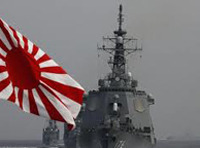Japan getting ready for war?
Tokyo has been taking active steps to strengthen the naval forces of Japan. Not so long ago, Japanese military held an official ceremony to launch the new helicopter carrier Izumo. Next year, the country plans to acquire amphibian vehicles for self-defense forces. The vehicles will be used for landing operations on islands.

The moves events have caused mixed reactions among Japan's neighbors, especially China. The further expansion of the Japanese naval power could break the fragile balance of forces in the region. The completion of the construction of the helicopter carrier coincided with another aggravation of the territorial dispute over the Senkaku Islands.
The Japanese authorities said that the vessel would not be used for attacks. The development of Izumo began in 2009. The ambitious project was worth a total of $1.5 billion. The length of Izumo is 248 meters, the displacement is 24,000 tons. The vessel is capable of carrying 14 helicopters on board, which will be designed primarily for rescue operations.
However, the Japanese military are not being honest, when they say that the ship can be used only for defensive purposes. Experts believe that the vessel can easily be transformed into an aircraft carrier. In addition, in July, The Japan Times wrote that the Department of Defense was planning to purchase two destroyers in 2015-2015. The Japanese Navy already has six of such ships, equipped with Aigis military information and control systems.
The Navy of Japan is one of the strongest in the region. In terms of the level of technical equipment, the Japanese Navy is almost no way inferior to the navy of China. The main advantage of China is the powerful submarine fleet.
Beijing does not hide its concerns about the military build-up of Tokyo. Interestingly, the Chinese media saw clear signs of militarism in the ceremony of launching the Izumo. "The helicopter carrier was called Izumo - the name was used for the flagship of the Japanese Navy squadron in the Chinese direction during the aggressive war against China," The People's Daily newspaper said.
In addition, the Japanese military are going to purchase American combat amphibious vehicles AAV-7 in 2014. Additional funds from the budget will be allocated for these purposes. These amphibians on crawlers are able to move by sea and land commandoes on islands. U.S. Marines already use them for military operations in different parts of the world.
As the actions of Japan, the Information Office of the Ministry of Defense of China stated that China was paying special attention to Japan's continuous military expansion. The neighboring countries and the international community should be vigilant in relation to the actions of Japan, Chinese officials said. The Japanese side should draw lessons from history, stick to defensive strategy and strictly follow the promise of peaceful development, the newspaper said.
Tensions started rising between the two countries over the dispute about the Dioyuydao Islands (the Japanese name for the islands is Senkaku). The diplomatic conflict between Japan and China began in September 2012, following the announcement of the nationalization of the archipelago by the Japanese government. The move came after the Senkaku Islands were purchased from private owners. Beijing sent a note of protest to Tokyo at that time. It is an open secret that the territorial dispute between Beijing and Tokyo over the Senkaku Islands has been lasting for many years already. According to the Chinese side, the islands were under the jurisdiction of China many centuries ago. Local historical sources speak of the early development of this area during the time of the Ming Dynasty. In 1895, Japan annexed the Senkaku Islands. China lost all of Taiwan.
After the Second World War, the Senkaku Islands were placed under temporary control of the United States. The new agreement, signed in 1971, provided for the transfer of the archipelago to Japan (China refused to recognize the legitimacy of the decision). One should not forget about another important document that gives China extra arguments in this dispute. The Potsdam Declaration, recognized by Japan after the surrender, stipulates all occupied territories, including the Diaoyu Islands, be returned to China. Most experts do not believe in the possibility of launching a full-scale war over tiny islands, at least in the coming years. However, tensions between the two countries can last for a long time. The territorial dispute over the Senkaku Islands, directly or indirectly, may trigger a new arms race in the region.
Today, Japan and China declare their readiness to engage in a dialogue on the issue of the disputed islands. In practice, no progress has been reached over the past year in the diplomatic settlement of the conflict over the Senkaku Islands. On the contrary, the two sides continue to test each other's determination. Chinese and Japanese patrol boats regularly visit the waters of the disputed islands. Last week, China once again reminded of itself by sending several Coast Guard ships to Dioyuydao. News agency reported then that the Japanese Ministry of Foreign Affairs summoned the Chinese ambassador to Tokyo to explain the move.
Just recently, four Chinese warships performed another maneuver in the waters of the disputed islands. As it should be done in such cases, the Japanese Foreign Ministry lodged a protest in connection with yet another incident near the Senkaku Islands.
Yuri Sosinski-Semikhat
Pravda.Ru
Subscribe to Pravda.Ru Telegram channel, Facebook, RSS!




